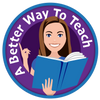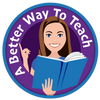If you’ve never used podcasts in your secondary classroom it may seem a bit daunting. Where do you even start? What does it look like? Is it worth the time and effort to figure out how to teach an entirely different type of literature.
Well, yes, yes, and yes. It’s worth it, and I’m here to make the whole process a little (or a lot) less intimidating. But first, if you’re curious about the why to teach podcasts, jump over to this blog post where I go into the research behind why it is so important that we teach this form of content (spoiler: it will make your students better readers with a better sense of digital literacy).

But this post is focused on the how of doing it. Let me give you four solid options for using podcasts in your ELA classroom. I’ve done most of these myself, and the ones I haven’t used myself, I’ve known colleagues who have been successful with implementing those in their classrooms.
1.) Use Podcasts As An Anchor Text Instead Of a Book
This method can be really great for your students who struggle with reading. It's also just a great strategy if you want to mix things up between teaching longer novels or books.
Let's say you’re going to teach a unit on the concept of social justice and you typically use the book To Kill a Mockingbird or Just Mercy as your anchor text. You have students read chapters of the book and you discuss characterization, plot, and themes.
You require that students make inferences and predictions. They have assignments where they have to analyze certain chunks of the text and other assignments where they make text-to-text and text-to-world connections.
All of those skills are great! But did you know you can teach all of those concepts with a podcast instead of a piece of literature. Now, a quick disclaimer--I love literature. And I absolutely believe part of being an ELA teacher is guiding students toward better reading and allowing for frequent reading.
But….I also believe in all those other skills I just mentioned: predicting, inferencing, analyzing, and making connections. And sometimes you can allow students to practice these skills with a different type of text.
For your ESL students, students with dyslexia, and your emergent learners this can be particularly empowering. By allowing these students to analyze a podcast that they have listened to instead of a text they must read, they will get to focus on these meaningful skills without the obstacle of actually decoding the words.

Continuing with the example above, if you were teaching a social justice unit, you might teach the podcast Serial instead of To Kill A Mockingbird. Many of the same questions will arise: What is justice? How is justice achieved? What is bravery? What does a society do to promote or suppress justice?
The other cool thing about a multi-part podcast like Serial is that it’s actually a significant amount of text for your students to wrestle with. If you provide students a transcript to read (perhaps projecting it on your board) while they listen, students will read about 288 pages by the end of the entire podcast!
Studies show that this is incredibly effective for helping your struggling readers. The act of listening and reading at the same time actually increases reading comprehension even when they go back to just reading. Read more about all of that here.
2.) Use Podcasts Paired With Literature
This is probably my favorite way to use podcasts in the ELA classroom. The concept is simple: pair a podcast with literature you are studying because it has a similar theme or addresses a similar topic or issue.
Let me give you an example. A few years ago, I was teaching a group of seniors and they were reading the book Tortilla Curtain by T.C. Boyle. Now, I personally think that Tortilla Curtain is a really fascinating novel, but it is a hefty text.
The story details the lives of two immigrants from Mexico and their struggles coming to and living in the U.S. Their story is juxtaposed with the story of a white, wealthy, suburban family who are having increasingly complex feelings about foreigners.

It’s an amazing book, but It’s set in the 90s, so it felt maybe a bit outdated to my students, plus, it’s a heavy book, as I mentioned. The themes are intense, the characters’ lives are tragic, and it’s also just a long novel.
I decided to pair this novel with the podcast Scattered which is a story about a Cuban immigrant who comes to America. The podcast describes his challenges assimilating; it's a memoir, told in six, 30-minute episodes, which makes it great for the classroom.
Scattered is told by Chris Garcia and it’s the story of his father. It’s an homage, and also a well-told story with elements of tragedy as well as humor. You fall in love with his family through listening to his story.
My students enjoyed the podcast because it was more current and less intense (though still incredibly meaningful). When my students listened to the podcast, they were able to more fully discuss the topics and motifs that overlapped in the novel and podcast: ideas such as assimilation, family, the outsider, alienation, and more.
It made the novel more relevant and our discussions were rich because students naturally made the connections.
There are a lot of other ways you can pair podcasts with literature because the world of podcasts has just exploded in recent years. Check out my blog post here where I give you some great ideas of podcast pairings, or if you want to teach this actual unit, grab my Scattered unit plan here.
3.) Use Podcasts As Mentor Texts For Writing
I am a firm believer in using mentor texts to teach all types of writing. Students must see how something is written through many examples before they attempt to do a certain type of writing on their own.
Podcasts provide great mentor texts, and a bonus is that students don’t have to read them, so your struggling readers can take in the information at more/less the same speed as your more proficient readers.
One way you can do this is when teaching the concept of personal narrative writing. I believe that personal narrative writing should be taught in every grade in high school because it’s one type of writing that people will use later in life.
Consider this: the first day you teach the personal narrative essay, you don’t give students a slide show presentation about what narratives are and are not. What if instead you had them listen to several stories from The Moth podcast or NPR’s Storycorps.
Give students a guided notes handout/graphic organizer and have them jot down things that stood out to them whether that involves content or form.
By the end of that class period, they’ll be able to tell you what narrative writing is.
You can do similar things when teaching other types of writing like persuasive writing (listen to an episode of Radiolab) or even poetry (consider Poetry Unbound).
4.) Use Podcasts in Conjunction with Project-Based Learning
I love project based learning because it allows students to take ownership of their learning, dive deep into their own interests, and produce meaningful creations that can affect change.
If your students are doing a passion project or some form of project-based learning, consider having the final project be a podcast that is available to others to hear.
Creating and producing a podcast is easier now than it has ever been even if you have no confidence in your tech skills (like myself).

The NY Times has some great resources like their project audio which will hold your hand through the entire process start to finish. It’s amazing.
The app Anchor is also a great and free resource that again allows your students to create an amazing podcast even if they have never done anything like this.
Now, it is worth spending some time on the front end really talking through things with your students as you would for any type of writing that they would do. They should ask themselves:
- What is the purpose of my podcast?
- Who is my intended audience?
- How will I achieve my purpose through the content I include?
- How will I speak to my intended audience and how will my diction be influenced by my audience?
Since they’re making a podcast they should also consider production aspects like:
- What production elements will I use to engage my listener
- What music will enhance my message?
- What information should I be sure to include and how will I present it (story, interview, etc.)?
These are all such powerful questions to consider and will allow students to go deep in thinking about the interplay between content and form.
An added bonus of making a podcast is that any time students have an authentic audience their work will be stronger. I write more on this concept here and other ways you can bring authentic audience into your classroom. If you take some time to explore the NY Times project audio you’ll see opportunities for your students to publish their podcasts for an authentic audience.
Takeaways:
Even if you have never used podcasts in your classroom, you can, and it’s absolutely worth it.
Use podcasts as an anchor text, pair podcasts with literature, or allow your students to create their own podcasts for deep, meaningful learning.
If you're looking to get started with podcasts, grab my podcasts for high schoolers bundle with includes two complete units, a mini unit, and a bell ringer. Check them out and take the hassle out of the prep work with lessons that have been used by hundreds of other teachers with great success!
Shop This Post
Podcasts For High School Bundle
Related Reading
3 Podcasts That Work In High School ELA
6 Poetry Podcasts For Your Classroom
Amazing Ways To Give Your Students An Authentic Audience
How To Use Podcasts To Teach English






Leave a comment